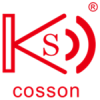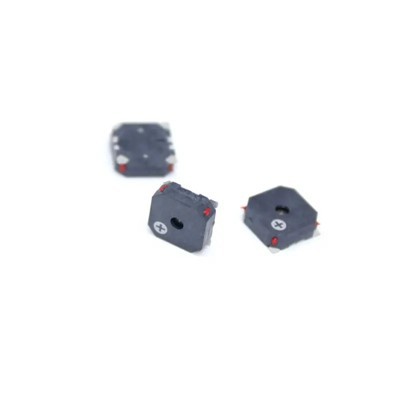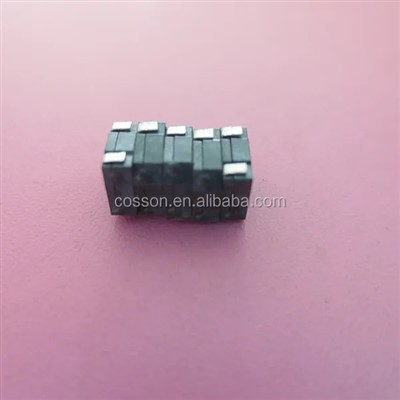SMD Buzzer
Foshan cosson Technology Co. Ltd is a professional enterprise engaged in manufacturing buzzer,sensor, piezeceramic, speaker and so on . The company is located in Guandong. Since its inception the company spirit of "Quality first, customer first" business philosophy, full participation, excellence, to provide high-quality products for customers !
Cosson has talent, technology, quality, service, strategy and other advantages.Meanwhile,it is optimizing work flow, casting excellence, continuing to revitalize the brand to maintain the leading position, the vision of a more broad, higher goals and dedicated to creating more value for customers. The company has developed a series of products which are widely used in the production: communication, household appliances, automobiles, electric bicycles, UPS power supply, alarm; instrumentation, electronic toy and electronic clocks and so on.

Why choose us?
01
Quality assurance
Quality is our culture, we believe that the quality is the soul of an enterprise.
02
Good service
Good after-sale service, handling the customer complaint and solve problem for customers.
03
Reasonable price
Our products are complete in variety, good in quality, reasonable in price.
04
Fast delivery
We may promise that we can try our best to finish all of your orders within the shortest time.
What is SMD Buzzer
SMD buzzer refers to the buzzer of the plastic shell, appearance and size of smaller, roll tape packaging, the pin can be flat to the PCB, patch type package is relative to plug-in type is another form of packaging of the buzzer. The product has the advantages of small size, light weight, sound clarity, firm structure, stable quality, high temperature resistance (a wave soldering) save manual welding labor; wherein, the electromagnetic SMD buzzer patch current consumption is relatively large, if you want to use a relatively small current power consumption is to use piezoelectric patch SMD buzzer. The piezoelectric SMD buzzer patch is mainly used in blood glucose meter, blood pressure meter, mobile phone alarm, security, microwave oven, induction cooker, lampblack machine, electric curtain, computer, automobile, electric vehicle, motherboard.
Benefits of SMD Buzzer
Compact design
SMD buzzers are significantly smaller and more lightweight compared to traditional through-hole buzzers, making them ideal for devices with limited space.
Efficient assembly
The surface mount design of these buzzers simplifies the assembly process, reducing manufacturing time and costs.
Enhanced reliability
SMD technology ensures a strong solder connection, reducing the risk of mechanical failure and increasing the component's overall reliability.
Diverse sound options
SMD buzzers are available in various sound options, including continuous, pulsating, and multi-tone sounds, allowing customization for different applications.
Application of SMD Buzzer
Alarms and security systems
SMD buzzers are used in alarms to provide audible alerts for security breaches, fire detection, and other emergency situations. They are also utilized in doorbells, motion detectors, and smoke detectors.
Consumer electronics
SMD buzzers are commonly found in consumer electronic devices such as mobile phones, tablets, laptops, and smartwatches. They are used for notifications, ringtones, and alerts.
Medical devices
SMD buzzers are employed in various medical devices, including patient monitors, infusion pumps, and medical alarms. They provide audible alerts for critical events, ensuring timely response and patient safety.
Automotive applications
SMD buzzers are used in automotive systems for warning signals, such as seatbelt reminders, door open alerts, and low fuel indicators. They help enhance vehicle safety and driver awareness.
Industrial equipment
SMD buzzers find applications in industrial equipment and machinery. They are used for signaling purposes, such as machine start/stop indicators, fault alarms, and equipment status alerts.
Home appliances
SMD buzzers are utilized in various home appliances like microwave ovens, washing machines, and refrigerators. They provide audible feedback and alerts for different operation modes or error conditions.
Electronic toys and games
SMD buzzers are commonly used in electronic toys and games to produce sound effects, musical tones, and notifications. They enhance the interactive experience and engagement of users.
Communication devices
SMD buzzers are used in communication devices like two-way radios, intercom systems, and walkie-talkies. They provide audible signals for incoming calls, messages, or alerts.
Industrial automation
SMD buzzers are integrated into industrial automation systems to indicate various events or alarms, such as machine faults, process completion, or sensor detection.
Audiovisual systems
SMD buzzers are utilized in audiovisual systems, including multimedia speakers, gaming consoles, and public address systems. They provide sound effects and alerts for a better audio experience.
Installation
Prepare the circuit board: Ensure that you have a suitable circuit board and necessary components to support the SMD buzzer.
Determine the mounting position: Identify the desired location on the circuit board where the SMD buzzer will be mounted. Consider factors such as sound distribution and accessibility.
Soldering: Apply a small amount of solder to the buzzer's solder pads and align them with the corresponding pads on the circuit board. Use a soldering iron to heat the pads and attach the buzzer securely. Be careful not to apply excessive heat that could damage the buzzer or the circuit board.
Verification: After soldering, visually inspect the connections to ensure they are properly soldered and secure. Check for any shorts or loose connections that could affect the functionality of the buzzer.
Usage
Electrical connections: Connect the positive and negative terminals of the SMD buzzer to the corresponding terminals on the circuit board. Refer to the datasheet or manufacturer's instructions for the correct polarity. Generally, the positive terminal is marked with a "+", and the negative terminal is marked with a "-".
Voltage and frequency: Determine the voltage and frequency requirements of the SMD buzzer for your specific application. Ensure that the voltage supplied to the buzzer matches its specified operating voltage range. Similarly, ensure that the electrical signals fed to the buzzer are within the specified frequency range for optimal performance.
Control signals: Depending on your application, you may need to control the activation and deactivation of the SMD buzzer. This can be achieved using microcontrollers, timers, or other electronic components to send appropriate signals to the buzzer. Follow the manufacturer's instructions or consult the datasheet for guidance on controlling the buzzer.
Testing and adjustment: After connecting the SMD buzzer and setting up the control signals, test the buzzer by activating it with appropriate signals. Verify that the buzzer produces the desired sound or alarm. If necessary, adjust the voltage, frequency, or control signals to achieve the desired sound output.
Safety considerations: Adhere to safety precautions when using the SMD buzzer. Avoid exposing the buzzer to excessive voltage or current that could damage it or the circuit board. Take necessary precautions to prevent short-circuits or electrical hazards.
How SMD Buzzer Works
Power source: The buzzer requires a power source to operate, typically a direct current (DC) supply.
Electromagnetic coil: Inside the buzzer, there is an electromagnetic coil. When electricity is supplied, the coil becomes magnetized.
Metal diaphragm: Adjacent to the coil, there's a metal diaphragm. This diaphragm is usually made from a ferromagnetic material, which means it's attracted to magnets.
Operation mechanism: When the current flows through the coil, it creates a magnetic field. This magnetic field causes the metal diaphragm to be attracted towards the coil, moving away from its original position.
Sound production: As the diaphragm moves, it compresses and rarefies the air in front of it, creating sound waves. The rapid movement back and forth of the diaphragm produces the buzzing sound we hear.
Oscillation: In some buzzers, particularly piezoelectric types, the electric current causes the piezoelectric material (usually a ceramic disc) to bend back and forth. This bending motion creates the sound. The frequency of the current determines the frequency of the sound, and thus its pitch.
Volume control: The volume of the sound can often be controlled by the amount of current supplied to the buzzer. Higher currents produce a louder sound.
How to Maintain SMD Buzzer




Regular cleaning
Dust, dirt, and debris can accumulate on the surface of the buzzer and affect its sound output. Periodically clean the buzzer using a soft, dry cloth or a brush to remove any particles.
Avoid excessive force
SMD buzzers have delicate components that can be damaged by excessive force or pressure. Handle the buzzer with care and avoid applying excessive force during installation, usage, or maintenance.
Check for loose connections
Over time, the solder joints or connections may become loose due to vibrations or thermal stress. Regularly inspect the connections to ensure they are secure. If any loose connections are found, re-solder them carefully.
Monitor environmental conditions
SMD buzzers can be sensitive to temperature extremes, humidity, and moisture. Avoid exposing the buzzer to extreme heat, cold, or high humidity environments, as it may affect its performance. If required, consider using additional protective measures such as conformal coatings or enclosures.
Test the sound output
Periodically test the sound output of the SMD buzzer to ensure it is functioning correctly. Verify that it produces the desired sound or alarm. If the sound output seems weak or distorted, check the electrical connections, voltage, and frequency to ensure they are within the specified range.
Follow manufacturer guidelines
Always refer to the manufacturer's guidelines, instructions, and datasheet for specific maintenance and upkeep recommendations. They may provide additional information, such as recommended operating conditions, cleaning agents, or specific precautions to be taken.
Keep documentation
Maintain proper documentation of the installation, maintenance, and any modifications made to the SMD buzzer. This documentation can be helpful for troubleshooting and future reference.
Periodic inspection and replacement
With continuous usage, the performance of the SMD buzzer may degrade over time. Periodically inspect the buzzer for signs of wear, damage, or decreased sound output. If necessary, consider replacing the buzzer with a new one to ensure optimal performance.

When choosing the SMD buzzer, you should also follow the operating principle to make a decision. Here you need to weigh some factors, such as the indicator and its driver circuit (usually built into the device). The device should be simple enough to implement a conventional plug and play mechanism. The SMD buzzer has an indicator, which is provided with the built-in circuit in the device. This feature enhances the flexibility of the buzzer. Although you must enter a DC voltage, because the frequency is internally installed, you can also get a pulsed audio signal. Transducers help you achieve great flexibility, including the use of specific frequencies and waveforms to produce a variety of sounds.
In addition to basic continuous sounds and pulse sounds, you should also be able to produce other sounds such as alarm sounds and prompt sounds. You can also increase the sound pressure level of the buzzer by increasing the device voltage. If you decide to use a full-bridge circuit, you should apply more voltage to the buzzer. When selecting a buzzer, size should also be a determining factor. The user should explain the needs to the manufacturer and have the supplier provide samples. The price should also be discussed.
There are different types of buzzers. SMD is just one of many. When selecting this buzzer, you need to be familiar with its functions. Here we are talking about the key elements of a buzzer. If you do not know the buzzer, you should contact a reliable manufacturer to help you choose the best buzzer.
Certifications

Our Factory
We attach great importance to, cherish all cooperation or cooperative partner of customers, to express the trust and expectations of our customers.Cosson's team of professional skills, has a very enthusiastic, with a lofty ideals and high aspirations enthusiasm and look forward to customers, together with the Chinese The electronic industry is booming as a modest, attained brilliant. Partnership, abide by integrity, common development!We firmly believe that the goods of electronic will continue to forge ahead, and you work together to create a better future! We hope to work with all of our overseas partners.Let's do it even better!



















